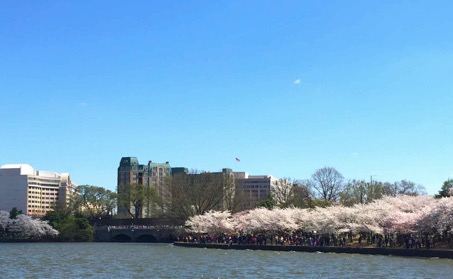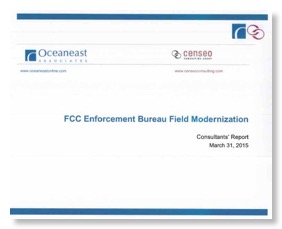Proposed FCC Spectrum Enforcement Cutback
Unconfirmed reports that #FCC will close ALL Enforcement Bureau offices in WA, AK, and HI - entire Pacific coast 2 be served by LA and SF
— Michael Marcus (@MarcusSpecSoln) March 11, 2015Above: our Twitter feed scooped everyone else on the news of the spectrum enforcement cutback on 3/10 and had a
key role in stimulating discussion on this vital spectrum policy issue
As your blogger first tweeted on March 10 , FCC is considering a major cutback in spectrum enforcement activities including both a staff reduction and office closings. We would fully agree that something iOS wrong with spectrum enforcement at FCC now and or the past decade or two, but it seems unlikely that this massive downsizing is the right answer. The proposal is based on a consultant’s report that you blogger has filed a FOIA request for on 03/17/2015 although nothing has been received. A package of related material was received from an outside FCC source and has been posted on DropBox. It consists of a 2 page letter from Chmn. Wheeler to House E&C Chairman Walden, a 2 page letter from Chief, Enforcement Bureau and the FCC Managing Director to the Enforcement Bureau Field Staff, and a 36 slide Powerpoint presentation. There is reportedly a 300 page report behind this, appropriate since the study cost $700,000 - much more than EB has spent in technical equipment in any year for the past several decades. Presumably, when FCC finally addresses the FOIA request we will know if the 35 page prevention is all FCC got for nearly $1M!
Let me bring up some issues that are not addressed in the available documents:
- This is an era of increased spectrum sharing in order to get maximum utilization of spectrum - a limited resource. Many parties, both in the federal government and in the private sector are reluctant to share their spectrum. After all, “what’s in it for them”? The 5 GHz U-NII unlicensed radar spectrum sharing policy change resulted in interference to a safety critical NOAA weather radar. FCC’s spectrum enforcement staff had to sort this out quickly and identify both policy issues and noncompliance issues. While this might not seem a classic function of the Enforcement Bureau, it is a function critical to FCC and its Title III role. In order to encourage future sharing and reallocations, FCC must maintain a credible posture for rapidly resolving such interference whether they are policy based or compliance based. Thus our biggest concern about this proposal is the loss of credibility of FCC spectrum enforcement. While NTIA likes to state publicly that it is in change of federal spectrum management, a more pragmatic approach is that large federal spectrum users such a DoD and FAA and well positioned to drag their feet on spectrum sharing if they don’t feel comfortable with enforcement issues.
- What will be the impact of the FCC enforcement downsizing on federal spectrum users and public safety spectrum users? While FCC could save resources by decreasing its spectrum enforcement staff, if other federal agencies respond by adding more staff and technical resources and if large state and local public safety agencies do likewise there will be no net savings. In particular, FCC spectrum enforcement staff has special legal authority for inspections that other agencies lack. So FAA can increase its staff, but their effectiveness is limited by the law.
- EB a long time ago lost interest in hard core spectrum enforcement. Your blogger worked in EB’s predecessor in the late 1980s after being exiled from OET because of the then controversial decision that is known as the foundation of Wi-Fi and Bluetooth. But during the few years he was there he was actively involved in 4 criminal prosecutions for violations of the Title III and related legislation: 2 satellite jamming cases, 1 Coast Guard false distress case, and 1 FAA air traffic control intrusion/“phantom air traffic controller” case. (There was another case where FCC pushed for prosecution after it identified the source of ATC intrusion, but FAA top leadership refused to cooperate for political reasons so there was no resulting prosecution.) It appears that since the creation of EB there has never been a similar criminal prosecution. While criminal prosecutions are not the only way to deal with spectrum violations, there are some dangerous and antisocial violations where criminal prosecutions are perfectly appropriate. Why hasn’t there been one in the history of EB?
- Historically, the field-based spectrum enforcement staff rotated around the field and some rotated into Washington. Some even transferred from field enforcement to DC-based policy positions. This cos fertilization was very constructive for FCC and resulted in 4 bureau chiefs: MB’s predecessors James McKinney and Lex Felker, WTB’s predecessor Carlos Roberts, and OET’s Richard Smith as well as many middle manager e.g. former IB branch chief Rick Engelman. But in response to Reagan Era budget cuts, FCC stopped virtually all agency funded moving of staff. Whereto this is even legal is debatable. But it certainly is a terrible personnel policy. You are hired in office x which is recent years have all had a tiny staff and you can only get more experience or a new environment if you more yourself to a new location. The consultant’s report says field spectrum enforcement staff morale is low - this long standing policy is a key factor.
- The importance of deterrence. When your blogger first came to FCC, Radio Shack was one of the largest retailers of Title III-regulated equipment. Dave Garner, their regulatory counsel, explained the importance of visible enforcement in equipment marketing. he explained further that product managers frequently tried to cut corners for a competitive edge and that he routinely had to plead to the CEO to block the development and marketing of noncompliant products. He could only do that because FCC had a credible enforcement program for equipment marketing enforcement. It no longer does. Neither EB nor OET wants to check what is really being marketed. What little surveillance there is is done by the commercial testing community which fundamentally has a conflict of interest! They are supposed to check post approval production units for 5% of the models they approve. But this is a sore point for the labs and there is no incentive for them to be suspicious. In reality, the only enforcement is in response to complaints from competitors, preferably those with a prominent lawyer representing them! (While I was in OET I was amused to see a former FCC chairman in private law practice walk in with another partner from his firm carrying a box of equipment. It turns out that his client made car battery chargers and alleged that a competitor charger was cheaper because it did not comply with FCC rules. While visiting the FCC Lab a few days later, I noticed that suddenly testing battery chargers had become a major project!)
- Note that if thousands of units of illegal equipment are sold in the US before they are noticed and action requested by a competitor or interferee, it will take a long time to remove these units from service as long as they perform a useful function for their owner. So delays in finding noncompliant equipment due to lack of effective market surveillance poses a real risk to all spectrum users!
If you agree with some of these points, we urge you to make your views known to the 8th Floor as well as the key Congressional committees. FCC spectrum enforcement needs some major changes, this type of massive slashing is not the right approach! Indeed, why not try a new approach in one region first and do a real experiment?
FCC Congressional Spectrum Testimony & Millimeterwave Spectrum

Keeping the Pipeline Flowing
In the fall of 2014, the Commission unanimously initiated a proceeding to explore the feasibility of using bands above 24 GHz for mobile wireless broadband and other wireless applications.The Commission is taking a proactive approach to examine the future evolution of wireless broadband technologies and determine what steps to take to create a flexible regulatory environment in which these technologies can flourish.Conclusion
The Nation’s leadership in wireless, and our ability to meet the wireless needs of consumers, depends in large part on spectrum resources. We will continue to pursue effective spectrum policies, leveraging the tools Congress has provided. We will also look to this Subcommittee for assistance and guidance in developing new, innovative approaches to spectrum management, and standready to work with Congress and our federal partners towards these important goals.
We agree completely with the last paragraph. However, there previous paragraph raises serious questions about present FCC policy. While indeed FCC “unanimously initiated a proceeding to explore the feasibility of using bands above 24 GHz for mobile wireless broadband” in Docket 14-177, it has paid scant attention to other “spectrum frontier”issues before it and has tried to narrow the scope of Docket 14-177 to minimize its applicability to non-CMRS applications. See fn 64 of the NOI to see how the drafters were looking for excuses to do as little as possible in this proceeding. In that footnote, they reference the TAC report on Spectrum Frontiers saying “TAC suggested instead that the Commission should carefully balance the benefits and risks of adopting service rules in these bands and take an active role to establish a framework for coexistence with passive services.”
- So what is FCC now doing to “establish a framework for coexistence with passive services”?
- What about the bands above 24 GHz where there are no passive allocations at all? (e.g. 122.25-123 and 158.5-164 GHz)
- What about the bands above 24 GHz where the passive allocations are co-primary, not primary? (e.g. 102-109.5 GHz)
- What does FCC think that Sections 7(a) and 303(g) of the Communications Act actually mean?

Millimeter wave technology - It really is different
Why is FCC acting so slowly?
FCC in a Better Light

It is cherry blossom time in DC at last after a long winter. The above photo shows “FCC in a better light”. (FCC is the building at right with the flag above it.)
Many visitors do not realize how close FCC is to the Tidal Basin, home of the most famous and most beautiful cherry blossoms in DC.
Comm. O'Rielly: "FCC’s Pre-Adoption Process Also Needs Work"

On April 1, an unfortunate choice of dates, Comm. O’Rielly posted on the FCC blog a post with the above title. This is an important issue to both improve the efficiency of FCC and its accountability to the commissioners. Below is what we posted on the FCC’s blog as a comment to this post:
I agree that reviewing and reforming FCC's 8th Floor process is vital. But part of this should also look at improving productivity and an objective review of whether the Commission as presently structured and operating is able to keep up with its whole workload. As our society and economy become increasing depending on telecom and IT and other countries are challenging our technical leadership in thee technologies, it is vital that the US enable not just large established industries to innovate, but also entrepreneurs.
As the Commission approaches the 30th anniversary of the Report and Order in Docket 81-413 next month, it is appropriate to recall both that this decision enabled a major expansion of unlicensed spectrum and applications that resulted in billions of dollars of economic activities and literally changed our lives through applications of Wi-Fi and Bluetooth, but this change appeared to be minor at the time and was actually opposed by almost all mainstream FCC regulatees at the time!
While doing only things that have a broad based consensus in industry has a certain appeal, if this test had been applied to the Docket 81-413 proposals, our world today would be very different.
While the Commission is devoting great efforts to the spectrum needs of the cellular industry and the concerns of the broadcasting industry, other issues are just not getting timely attention. Even the cellular industry has to ration carefully its requests for the Commission’s limited capacity on Title III issue.
Consider the long drawn out history of Docket 10-4 dealing with interference from some “cellular booster” models to cellular base stations. From CTIA’s first formal presentation to FCC on this issue on May 1, 2006 to the adoption of rules on this issue took almost 10 years! The ongoing interference from FM broadcast stations to 700 MHz LTE cellular base station appears to need a rulemaking resolution since there may be a rule contradiction at its base. But it appears that this issue is way off the Commission’s “radar” as the cellular industry would prefer to focus on new spectrum first. The Commission has never even acknowledged this issue except in some obscure EB letters issued by offices “outside the Beltway”.
If the delays of Docket 10-4 look bad, consider the case of Docket 01-278 which dealt with unexpected but repeated interference from police radar detectors (the type that are illegal in 20+ states) to VSAT receivers. While the NPRM and R&O imply the issue was resolved in less than 2 years, in reality it took even longer than Docket 10-4! (I worked at FCC at the time and was fully aware of what was going on but it was not acted on until the problem started spiraling out of control. If the commissioners had been aware of this issue and had consciously decided to defer it based on an estimate it would go away, the delay might have been more understandable. But I am certain they were not aware and probably the several chairmen of that era were not aware either.)
Innovative spectrum application, both for telecom and nontelecom services keep appearing and there is an unspoken threshold of support needed for them to get action from the Commission as presently structured and operating. Petitions for rulemaking, either from innovators or coalitions, can linger in the Commission’s “petition black hole” for years without any action - as the 40 GHz RM-11664 petition from Fixed Wireless Communications Coalition did. The IEEE-USA Docket 13-259 petition on Section 7’s applicability to spectrum above 95 GHz that totally lack ANY service rules as well as the Battelle RM-11713 petition for service rules at 105 GHz have neither been acted on nor dismissed. This lack of action on spectrum above 95 GHz coupled with the wording of the Docket 14-177 NOI that tries to minimize its applicability (see fn. 64) to noncellular spectrum uses sends a chilling message for private capital formation for R&D above 95 GHz at the time when our international competitors are actually subsidizing such R&D!
There are a number of noncommunications products now being produced and sold above 95 GHz in the US that the Commission is “turning a blind eye” to. Such “Terahertz spectrum” has some properties related to infrared technology and is useful in laboratory analysis. However, regulatory ambiguities about this technology may well impede capital formation for it and raise “due diligence” issues if a firm wanted to acquire a startup with such technology. This technology is noncontroversial in the spectrum community, but it also has not met the unstated FCC threshold of support needed for serious FCC consideration. Is this consistent with the mandates of Sections 7(a) and 303(g) of the Communications Act to “encourage the provision of new technologies and services to the public” and “generally encourage the larger and more effective use of radio in the public interest”?
But shouldn’t the FCC be able to BOTH make new spectrum available for new applications, especially in “virgin bands” such as above 95 GHz, as well as solve the inevitable new interference problems that arise within existing bands and services in a timely way?
In changing procedures the Commission should consider also how it can speed up deliberations on technical Title III issues. A general reduction of delegated authority to staff might be a move in the wrong direction with respect to increasing productivity in Title III, although consensus building is need to see what approaches are acceptable to the Commissioners. But first it has to acknowledge that there is a productivity problem.
If it acknowledges (at least internally) a Title III productivity shortfall, it might wish to consider the suggestions of IEEE-USA on “Improving U.S. Spectrum Policy Deliberations in the Period 2013-2017” that have attracted little interest in the Commission so far.






![Validate my RSS feed [Valid RSS]](valid-rss-rogers.png)

